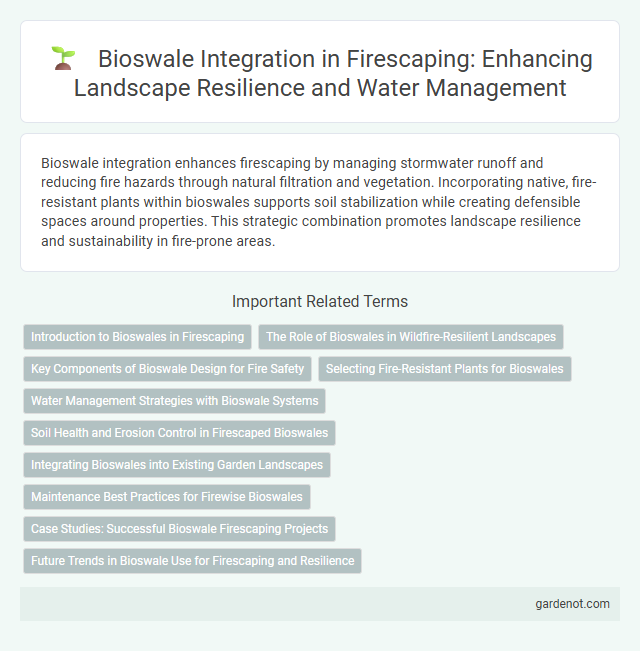Bioswale integration enhances firescaping by managing stormwater runoff and reducing fire hazards through natural filtration and vegetation. Incorporating native, fire-resistant plants within bioswales supports soil stabilization while creating defensible spaces around properties. This strategic combination promotes landscape resilience and sustainability in fire-prone areas.
Introduction to Bioswales in Firescaping
Bioswales in firescaping serve as engineered landscape features designed to manage stormwater runoff while enhancing fire-resistant vegetation zones. These vegetative channels filter pollutants, reduce erosion, and promote infiltration, contributing to both ecological restoration and wildfire mitigation. Integrating bioswales strategically within defensible spaces supports sustainable water management and creates natural firebreaks to protect property and ecosystems.
The Role of Bioswales in Wildfire-Resilient Landscapes
Bioswales play a critical role in wildfire-resilient landscapes by managing stormwater runoff and reducing soil erosion, which helps prevent fire spread across sloped terrains. These vegetated channels capture and filter pollutants while maintaining moisture in the soil, creating natural firebreaks that slow down flames and protect adjacent vegetation. Integrating bioswales into firescaping designs supports ecosystem health, enhances biodiversity, and promotes durable landscape fire protection strategies.
Key Components of Bioswale Design for Fire Safety
Bioswale design for fire safety prioritizes vegetation selection, emphasizing fire-resistant and low-flammability plants to minimize ignition risk. Incorporating engineered soil mixtures with high moisture retention supports plant health and acts as a natural fire barrier. Effective drainage systems reduce water accumulation, preventing dry conditions that could enhance fire spread within the landscape.
Selecting Fire-Resistant Plants for Bioswales
Selecting fire-resistant plants for bioswales enhances landscape resilience and reduces wildfire hazards. Species such as manzanita, ceanothus, and California lilac exhibit low flammability while providing effective stormwater filtration and erosion control. Incorporating native drought-tolerant plants with high moisture content further supports bioswale functionality and fire safety.
Water Management Strategies with Bioswale Systems
Bioswale integration enhances water management strategies by effectively capturing and filtering stormwater runoff, reducing surface water pollution and mitigating flood risks. These engineered landscape elements promote groundwater recharge and support sustainable drainage systems through vegetation and soil media designed for optimal water infiltration. Incorporating bioswale systems in urban planning contributes to resilient green infrastructure by improving water quality and managing peak flow volumes in combined sewer overflow areas.
Soil Health and Erosion Control in Firescaped Bioswales
Firescaped bioswales utilize bioswale integration to enhance soil health by promoting microbial activity and increasing organic matter content, which improves water infiltration and nutrient cycling. The specialized vegetation and engineered soil layers in these bioswales stabilize the soil, significantly reducing erosion during heavy rainfall or fire events. Effective erosion control in firescaped bioswales mitigates sediment runoff, protecting surrounding ecosystems and maintaining landscape resilience against fire-induced soil degradation.
Integrating Bioswales into Existing Garden Landscapes
Integrating bioswales into existing garden landscapes enhances stormwater management by naturally filtering runoff and reducing erosion. Native plants and grasses within bioswales promote soil infiltration while supporting local biodiversity and improving aesthetic appeal. Proper grading and placement ensure effective water flow, seamlessly blending sustainable design with garden functionality.
Maintenance Best Practices for Firewise Bioswales
Firewise bioswales require regular maintenance to ensure effective water filtration and fire resistance. Clearing debris, controlling invasive plants, and monitoring soil moisture levels prevent fuel buildup and maintain plant health. Routine inspections and selective pruning promote fire-adapted vegetation growth, reducing wildfire risk while enhancing bioswale function.
Case Studies: Successful Bioswale Firescaping Projects
Case studies of successful bioswale firescaping projects demonstrate significant improvements in fire resilience while enhancing stormwater management and biodiversity. Notable examples include California developments where bioswales effectively reduce wildfire fuel loads and promote native vegetation recovery. These projects highlight the integration of ecological fire prevention with sustainable urban water management strategies.
Future Trends in Bioswale Use for Firescaping and Resilience
Future trends in bioswale integration for firescaping emphasize enhancing landscape resilience by using native, fire-resistant plant species that improve water filtration and reduce wildfire risk. Advanced bioswale designs incorporate smart irrigation and real-time monitoring systems to optimize stormwater management while maintaining ecological balance. Increasing urban adoption of bioswales reflects the growing recognition of their dual role in wildfire mitigation and sustainable water management.
Bioswale integration Infographic

 gardenot.com
gardenot.com